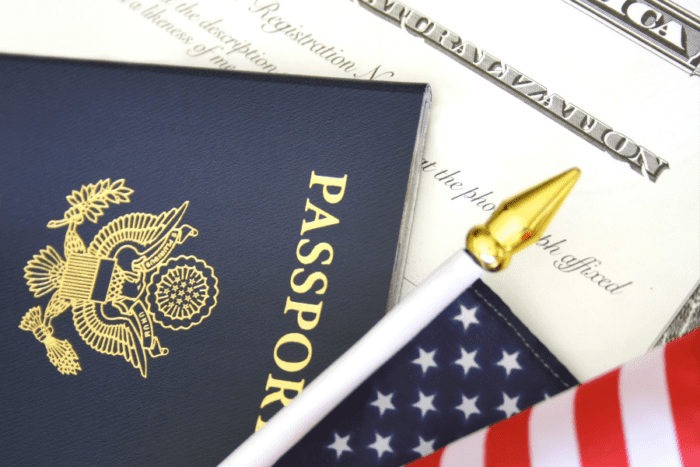Expatriation Tax Planning for Citizens Leaving the US
May 8, 2025
‘The two hardest things to say in life are hello for the first time and goodbye for the last.’
American author Moira Rodgers could have been discussing renouncing US citizenship when she wrote those words.
On the surface, her words highlight the challenges of new beginnings and severing old ties.
But what if saying goodbye was the gateway to new opportunities?
What if accepting a certain amount of temporary discomfort was an inevitable part of making progress in achieving your life goals?
Welcome to the quandary facing US citizens considering whether to renounce their citizenship:
Should they?
Shouldn’t they?
For some, boldly stepping through the looking glass and embracing a life beyond the familiar is the only viable path.
Those who take this leap understand that the first step is often the most daunting: It’s not easy to say goodbye to US citizenship and try to establish oneself in a new country.
And if you do say goodbye to the US, there’s a lot you’ll need to prepare for before you simply fly away.
One of the biggest considerations is what will happen to your taxes.

Tax Planning for US Expats
The most important thing for expats to understand is the US’s citizenship-based taxation system.
Quite simply, this means you have to report and file tax returns to the IRS every year, no matter where you live or earn money. The only way to get out of this is by renouncing your citizenship (which we’ll cover in more detail below).
As an expat, that means you have two tax systems to worry about – the US and your new country of residence.
However, you can take advantage of the Foreign Earned Income Exclusion, which allows Americans living abroad to exclude up to US$130,000 of foreign-earned income from federal income tax.
What Does Renouncing Your US Citizenship Mean?
Renouncing US citizenship is an irreversible legal process allowing applicants to formally relinquish citizenship.
When you renounce, two things happen. First, you lose all your rights as a US citizen, meaning you can no longer vote or use social services or your US passport.
On the upside, it means you’re free from the world’s most draconian taxation system.
Unlike other countries, all US citizens must file and pay an annual tax return to report their worldwide income to the Internal Revenue Service (IRS).
There’s no way around it for US citizens: renunciation is the only legal way to fully relieve yourself of the US tax burden. Though, that’s not the only reason many have done it.
Other motivations include wanting to live and fully integrate with another nation and culture, frustration with US politics and general dissatisfaction with American life.
While renouncing is not for everyone and must be considered carefully, for many expats, the move comes with benefits worth pursuing.

What Is the US Exit Tax and How Does it Work?
When renouncing US citizenship and dealing with the exit tax, taking time to organise your affairs can greatly lower your taxes before you leave.
This is because the US Government imposes a market-to-market exit tax on all of your assets on the day of your expatriation. This ‘deemed sale’ can be complex to understand, so preparation is key.
Before formally renouncing your citizenship, you must calculate your net worth and file a final tax return with the IRS. This includes the value of your businesses, the cash you have and all of your assets.
As such, the exit tax is a hypothetical sale of your assets on the day before your renunciation. You’re not really selling them, but the IRS will tax you as if you did.
For example, if you purchased shares for US$1,000 that are now worth US$1,800, the unrealised gain of US$800 becomes taxable if you’re considered a ‘covered expatriate’.
Covered expatriates are subject to the current expatriation tax rules and may be required to pay an exit tax upon renouncing their US citizenship. This encompasses individuals who meet any of the following criteria:
- Net worth exceeding US$2 million
- Non-compliance with US tax obligations
- Average annual net income tax over the past five years exceeding a specified threshold (adjusted for inflation).
US Exit Tax Rate
The US exit tax rate can reach up to 23.8%, but it applies only to unrealised capital gains. You won’t be taxed again on income that has already been taxed.
Under the IRS’s mark-to-market regime, all property of a covered expatriate is deemed sold for its fair market value. The amount that would otherwise be included as gross income through the deemed sale is reduced by an exclusion amount of US$890,000 in 2025.
You are required to submit your tax return for the previous five years and list all of your worldwide assets and it’s your responsibility to be compliant.

Minimising the Expatriation Exit Tax
One of the most effective ways to reduce your expatriation exit tax liability is through gifting.
This strategy is particularly useful for couples where one spouse is renouncing their citizenship and the other is not.
You can also choose to gift your assets to your kids or even a trust. Every individual gets a lifetime gifting exemption, which means they can gift up to a certain amount tax-free.
Based on the current lifetime gift exclusion of US$5 million, assets up to that value can be gifted tax-free.
As those assets will still be taxed in the US, even if you renounce, you can legally reduce your exit tax bill if you gift them.
Let’s look at this in practical terms: An individual with a net worth of US$3 million could strategically gift assets to bring their net worth below the US$2 million threshold, thereby avoiding the exit tax altogether.
While it may be more challenging for someone with a net worth of US$50 million to eliminate their exit tax liability entirely, substantial savings are still possible through strategic gifting.
It’s important to note that you cannot gift in the same year as the renunciation. So, ideally, you would make the gift one year and then wait a whole year or until January 1 of the following year to actually renounce.
As ever, planning this is crucial.
How to Renounce US Citizenship

The first step is to set and attend two different appointments at a US embassy or consulate.
At the first interview, you will be asked to complete a DS-4079 renunciation questionnaire. The questionnaire lists all the questions about where you are naturalised, whether you were born a US citizen, your citizenship of another country and so on.
During the interview, you will have to elaborate on why you want to renounce your US citizenship.
The initial interview establishes that you are renouncing of your own free will and that you’re aware of the consequences. Then, depending on the embassy or consulate, you may be asked to return for a second interview.
The most important question you will probably be asked is why you are renouncing. One reason the US Government does not accept is that you want to renounce for tax purposes.
To learn more, see our Ultimate Guide to Renouncing US Citizenship.
You will complete several documents throughout the process, including the DS-4080, 4081, 4082 and 4083 forms. You are then required to take an oath stating that you want to renounce.
A fee of US$2,350 must be paid and, on the tax side, you must file your final US tax return on the day before you renounce and list your assets.
If you are retaining US-source income from assets like pension and property, you may have to continue to file Form 1040 after you renounce.
In truth, the process has not been made easy for applicants, but the benefits can far outweigh the efforts.ve to continue to file Form 1040 after you renounce. In truth, the process has not been made easy for applicants, but the benefits can far outweigh the efforts.
Expatriation Tax Planning: FAQs
It’s the legal process of formally surrendering US citizenship. Once done, it cannot be reversed, and the rights that can be claimed as a US citizen no longer apply.
Renouncing US citizenship allows you to become a citizen of another country, with better financial, tax and lifestyle benefits available elsewhere.
Renouncing also means that, regardless of where you live and work, you are no longer liable to pay US citizenship-based taxes or report your income to the IRS.
The day before you renounce, you must file a final tax return with the US Government. This includes your tax return for the previous five years and all your worldwide assets, such as property, cash and businesses. An exit tax is calculated on the hypothetical sale of those assets.
A covered expatriate is one who must pay an exit tax if renouncing US citizenship because they are ‘covered’ under the US tax code.
An exit tax of up to 23.8% is calculated on any unrealised gains from the deemed sale of all assets of a covered expatriate. A covered expatriate is a tax-compliant individual with a net worth of over US$2 million and an average net income of over US$201,000 for the five years before renouncing.
As a covered expatriate, you cannot avoid the exit tax, but with careful tax planning, you can legally minimise it. Typically, the strategies used to reduce the exit tax are gifting to a spouse, children or a trust up to the limit of your tax-free exemption and seeking a fair valuation of any businesses you own on renouncing.
Is US Expatriation Tax the Final Piece of Your Puzzle?

This overview of the US exit tax points to the complexities of renouncing US citizenship. It’s a process fraught with tax and legal intricacies, requiring meticulous planning for those seeking a successful Plan B.
At Nomad Capitalist, we work with international tax attorneys and tax accountants to coordinate global plans for people who intend to renounce.
There’s a lot to think about, and mistakes can be costly. If you plan on renouncing, you need a plan for what happens with your banking, businesses, investments and taxes when you leave.
We help seven- and eight-figure entrepreneurs and investors create a bespoke strategy using our uniquely successful methods. This will allow you to keep more of your own money, create new wealth faster and be protected from whatever happens in just three steps. Discover how we do things here.


Does Puerto Rico Pay Taxes to the US?
It’s a common question and one that often fuels confusion, debate, and a fair share of misinformation – Do residents of Puerto Rico actually pay US federal taxes? When most people think of US tax obligations, they naturally assume they apply uniformly across all US citizens. But when it comes to Puerto Rico, things are […]
Read more

Zug Canton Taxes: The Ultimate Destination for Wealth Management in Switzerland
Switzerland’s global reputation is built not just on stunning views of Alpine peaks and serene lakes but also on a foundation of exceptional quality of life, world-class infrastructure and investor-friendly tax policies. The results speak for themselves: efficient public transport seamlessly links cities and villages; the standard of living regularly ranks among the highest in […]
Read more

How Smart Investors Use Venture Capital to Build Wealth
Big companies like Google, Amazon, Facebook and Apple all started out as bold ideas backed by venture capital. Decades later, the same firms are household names, as familiar to most people as electricity, the internet, or the telephone. But hindsight is a fickle friend. The truth is, it wasn’t always so obvious they’d succeed. These […]
Read more




